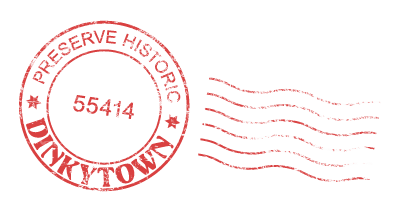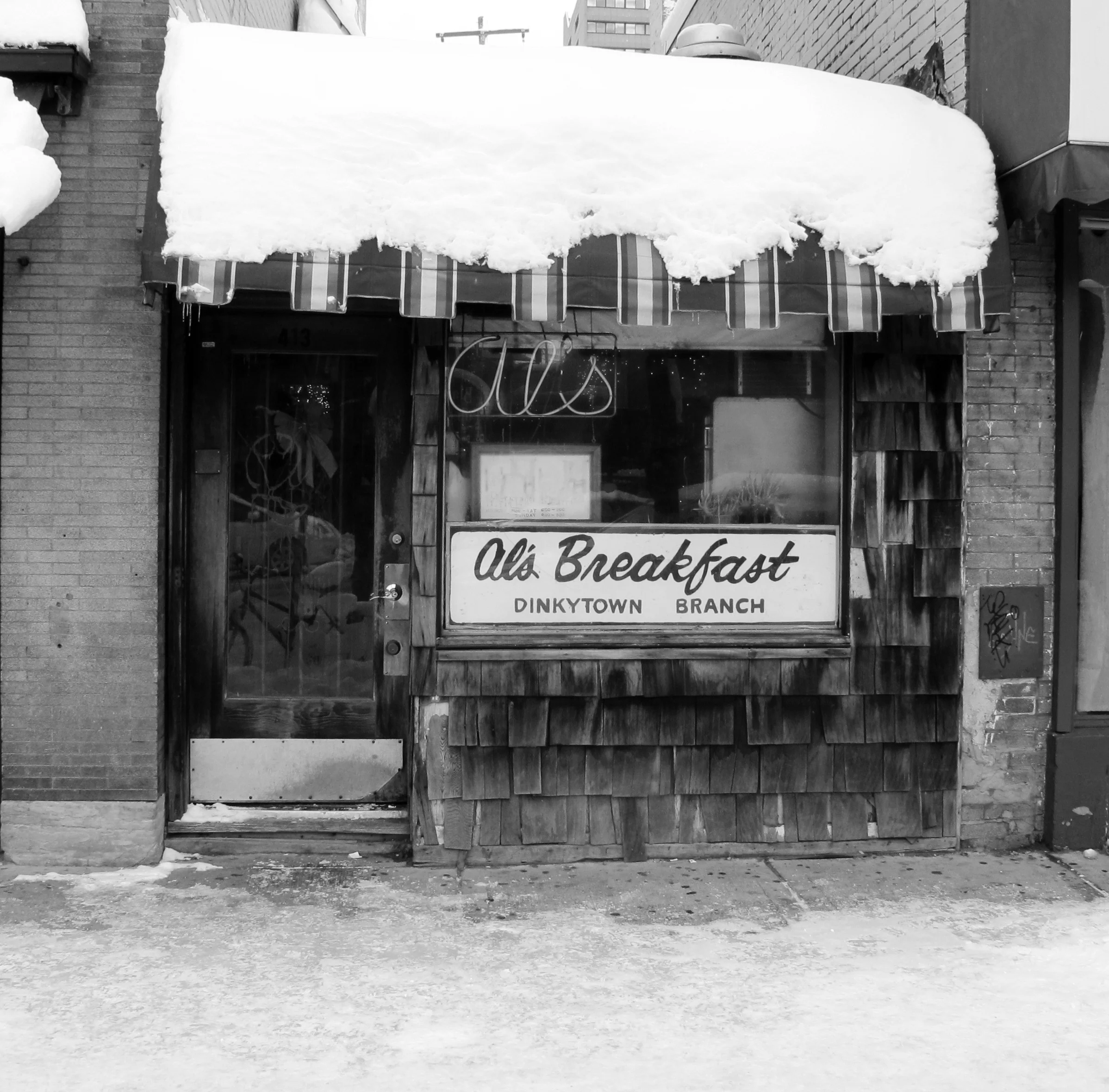Legendary Gathering Places
Bob Spitz, in Dylan: A Biography (Norton, 1989), describes the Dinkytown of the late 1950s: what happened to Bobby Zimmerman in Dinkytown was just one example of the personal and social transformations wrought by a foray into Dinkytown’s microcosmic generator of the movements and mores of the times.
Spitz compares Dinkytown to Haight Ashbury and Greenwich Village, where Dinkytown notables later circulated and contributed key elements of what became known in the 1960s and 1970s as “The Movement.”
“Toward the end of the 1950s, Dinkytown managed to inspire and maintain a cultural renaissance of its own. Adjuncts of university classes taught by John Berryman, Allen Tate, James Wright, Saul Bellow, and Robert Penn Warren spilled over into the café society that spawned within a three-block hive of provincialism built around the intersection at Fourth Street and Fourteenth Avenue. Their graduate students held court around tables at Bridgeman’s ice-cream parlor, the East Hennepin Bar, or the Varsity Café…There they could sit over coffee and lionize their mentors, distracted only by the scene’s hip signature – wine, jazz, and marijuana.
“…Their “new vision,” so to speak, personified what sociologist Morris Dickstein…(Gates of Edne), referred to as Romantic Socialism…C. Wright Mills called these harbingers of a new society “the young intelligentsia” and hailed them for their courage to rebel against the barren spirit of the Eisenhower era.
“Those less inclined to take on society’s problems subscribed to the Beat life-style of hanging loose, which was endemic to Dinkytown. Al’s Breakfast opened at five a.m. to attract the all-night crowd that the restaurant’s namesake considered to be oddly fascinating. From there you could drift farther along Fourteenth Avenue to Yohanda Cleaners, where a card game was always in progress, or hit an art film at the Varsity Theater.
“During the day, the Scholar attracted an in-group of Dinkytown’s self-styled heads, presided over by Melvin McCosh, the Scholar’s resident radical. A parlor anarchist who was a good ten years older than the rest of the crowd, McCosh ran an alternative bookstore a few doors away where fellow sympathizers gathered to play cards, philosophize, and rail against America’s Realpolitik...Around nine each night, the lights would dim as performers to the makeshift stage directly in front of the Scholar’s window.”
On a more scholarly note, the extended entry on “Counterculture” in the Oxford Encyclopedia of American Cultural and Intellectual History (Oxford, 2013) summarizes the experience:
“Perhaps the best way to characterize the counterculture is that it was an assemblage of ideological, political, and cultural positions defined most of all by the fact that when brought together, they raised uncertainties about the very contours of the counterculture itself…It was more what sociologist Bruno Latour calls an “atmosphere of democracy” than a fully developed and stable ideological platform. It was hybrid, polyglot, pluralistic, and impure. It circulated through commodities and mass-mediated portrayals as well as what cultural theorist Stuart Hall called a “modern ‘bush-telegraph’” of alternative “underground” publications.
“The counterculture spread through word of mouth as much as through official statements and communiqués. It radically changed the lives of some people, causing them to fundamentally alter their everyday existence; others merely incorporated aspects of the counterculture into accepted activities and beliefs. The counterculture became a kind of filigree of intermediary zones, liminal spaces, and wavering signals in which the stakes of personal and social transformation were raised but complete transformation was not necessarily guaranteed.”
Dinkytown was one of the “intermediary zones” and “liminal spaces” that incubated the American counterculture.
The Four Corners
The four corners at Dinkytown’s iconic central intersection of 4th Street and 14th Avenue were a major posting place for local events, and a distribution point for flyers, petitions, and literature of all sorts. Petitions are still collected here for environmental and political groups. Cell phone distributors set up here every fall to capture student markets.
The Ten O’clock Scholar
418 14th Ave. S.E.
In the ‘50s and ‘60s the Ten O’clock Scholar is where the music happened. John Koerner, Dave Ray, and the Bob Dylan spent the early days of their performance careers there. Judy Larson of the Sorry Mothers (later to become part of the beloved Prairie Home Companion duo, Judy Larson and Bill Hinkley) hung out at the Scholar as a teenager. It is best-remembered as the coffee house where Bob Dylan got his start.
“John (Koerner) later befriended a young genius poet and Leadbelly devotee named Dave Ray. His family lived in the neighborhood, and he went to University High School, just down the block from The Scholar. At 15, he was spending every spare minute hanging around and sopping up Underground Culture…Around this time, a rather pushy college sophomore named Bobby Zimmermann began dropping in.”
from Stan Gotleib’s memoir "An Inappropriate Life"
❦ READ MORE: "An Inapproprite Life" by Stan Gotleib
In a biography he provided to the Minneapolis Jewish World, Bill Savran recalls:
“The folks that gathered at The Scholar were philosophers, alcoholics, grad students, writers, poets, wannabe writers and poets, hangers-on, musicians of all kinds: strummers, singers, tambourine shakers, bongo thumpers, mouth harpists and so on. Spider John Koerner was a standout and of unique natural talent. I met him the late summer of 1958, in San Francisco, just after he had been discharged from the Marines.”
❦ READ MORE: Dinkytown's Magic Moment
Al's Breakfast
414 14th Ave. S.E.
Since 1950, Al's Breakfast has been serving no-frills hardy breakfasts to the Dinkytown community north of the University of Minnesota. It is a legend of its own. Its pottery mugs and accoutrements were created by renowned Minnesota potter Peter Leach who frequented Al’s back in “the day.”
Vescio's
406 14th Ave. S.E.
Vescio's Italian Restaurant has been serving authentic Italian cuisine for over 50 years. It is known for its unique sandwiches and homemade pastas, as well as handmade meatballs, dressings and sauces. Vescio's is one of the oldest, still extant, gathering places. Family owned after all these years, it is run by Eileen and Frank Vescio along with their son Tony, who is now the third generation. Vescio’s is still an important meeting place for emeritus faculty, students, and alumnae.
Valli Pizza
412 14th Ave. S.E.
Valli Pizza was open 24 hours upstairs and had a three-two beer joint downstairs along with a pool hall. It was in this basement grotto that Connie Hechter played jazz piano on weekends. According to Andy Driscoll, Valli was THE place to be on a Friday night after classes.
Mama D's
corner of 4th St. and 13th Ave. S.E.
"Love is the main ingredient." – Mama D
Giovanni D’Agostino was a big-hearted restauranter who fed the poor, supported the outcast (such as Jack Baker, a gay marriage applicant in the 1970s), taught the Riverside Café bakers how to make bread in the basement of at Hope Lutheran church in Dinkytown, and ran for mayor in 1981, garnering 10% of the votes. She also hosted the first ever Loft membership party, which Garrison Keillor emceed.
Her son John, said, "She was everybody's mom. She called the hippie generation her kids, and she loved them."
She wrote three Italian cookbooks and was a frequent guest on national television programs hosted by Mike Douglas, Dinah Shore, and Regis Philbin.
According to J. Maguire’s blog testimony, “This picture is Mama D’ and Jack Baker. Jack inspired us about same sex marriage. He was the pioneer. Mama D’ was a saint. Mama D’ fed me many times when I was really broke and hungry. She always saved special dishes for students, etc., who would come by for a free meal."
Now transformed into the Library Bar, this location had been a famous meeting ground of Goldie’s Gophers back in the ‘30s and ‘40s, when it was known as the “Little Brown Jug.”
Gray's Drugstore
SW corner of 4th St. and 14th Ave.
One could always expect to see faculty, students, and Dinkytown residents in Gray’s Drugstore. The lunch counter is featured in a number of stories and poems about Dinkytown encounters with John Berryman and other notables. The corner was also a central gathering point for Dinkytown street life, musicians and political activity.
Bridgeman’s
S.E. corner of 4th St. and 14th Ave.
A famous hangout for decades, and the site of the ‘sit in’ protesting the ousting of McCosh’s Bookstore from the rear end of the building when Bridgeman’s expanded in the late ‘60s.
Many of the stories submitted to Preserve Historic Dinkytown feature this site. It is now part of the Potbelly chain of fast food restaurants.






